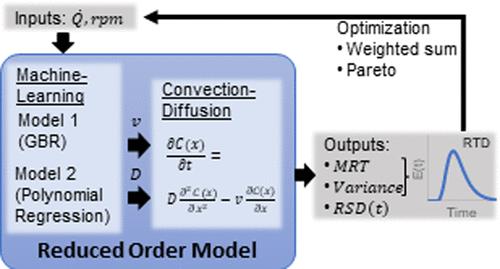当前位置:
X-MOL 学术
›
Ind. Eng. Chem. Res.
›
论文详情
Our official English website, www.x-mol.net, welcomes your feedback! (Note: you will need to create a separate account there.)
Semi-Mechanistic Prediction and Optimization of Residence Time Metrics of a Starve-Fed Extruder via a Hybrid Machine-Learning Convection–Diffusion Model
Industrial & Engineering Chemistry Research ( IF 4.2 ) Pub Date : 2024-04-11 , DOI: 10.1021/acs.iecr.4c00201 Ashley Dan 1 , Urjit Patil 2 , Erik Holmen Olofsson 3 , Jesper Henri Hattel 3 , Rohit Ramachandran 1
Industrial & Engineering Chemistry Research ( IF 4.2 ) Pub Date : 2024-04-11 , DOI: 10.1021/acs.iecr.4c00201 Ashley Dan 1 , Urjit Patil 2 , Erik Holmen Olofsson 3 , Jesper Henri Hattel 3 , Rohit Ramachandran 1
Affiliation

|
This study addresses the challenge of determining mixing dynamics, such as the residence time distribution (RTD) and relative standard deviation (RSD) of a system, which usually require tedious experimental setups or computationally intensive models. A reduced order model (ROM) in the form of a machine-learning-based convection–diffusion model was developed for the computationally efficient prediction of mixing metrics. A two-dimensional compartmental convection–diffusion model was applied to a starve-fed single screw extruder, capturing non-uniform axial velocity fluxes. The model was enhanced through machine learning algorithms to establish correlations between process parameters, velocity fluxes, and diffusion coefficients. The use of a convection–diffusion model provided a mechanistic prediction of RTD and RSD. The model accuracy was demonstrated via an R-squared value of above 0.9 for the prediction of different metrics evaluated, such as mean residence time and variance. The calibrated model was then optimized to identify improved input conditions that led to the desired mixing metrics. The developed ROM provided an efficient alternative to the full computational fluid dynamics (CFD) model by substantially reducing the computational time from 44 h to 2.5 s while retaining model accuracy. Source codes for the model are available on GitHub repositories at https://github.com/adan626/ROM_CFD and https://github.com/patilurjit/CFD-ML.
中文翻译:

通过混合机器学习对流扩散模型对缺料挤出机的停留时间指标进行半机械预测和优化
这项研究解决了确定混合动力学的挑战,例如系统的停留时间分布 (RTD) 和相对标准偏差 (RSD),这通常需要繁琐的实验设置或计算密集型模型。开发了一种基于机器学习的对流扩散模型形式的降阶模型 (ROM),用于计算有效地预测混合指标。将二维隔室对流扩散模型应用于饥饿供料单螺杆挤出机,捕获不均匀的轴向速度通量。该模型通过机器学习算法得到增强,以建立过程参数、速度通量和扩散系数之间的相关性。对流扩散模型的使用提供了 RTD 和 RSD 的机械预测。模型的准确性通过高于 0.9 的R平方值来证明,用于预测不同评估指标(例如平均停留时间和方差)。然后对校准模型进行优化,以确定改进的输入条件,从而获得所需的混合指标。所开发的 ROM 通过将计算时间从 44 小时大幅减少到 2.5 秒,同时保持模型精度,为完整的计算流体动力学 (CFD) 模型提供了有效的替代方案。该模型的源代码可在 GitHub 存储库上获取:https://github.com/adan626/ROM_CFD 和 https://github.com/patilurjit/CFD-ML。
更新日期:2024-04-11
中文翻译:

通过混合机器学习对流扩散模型对缺料挤出机的停留时间指标进行半机械预测和优化
这项研究解决了确定混合动力学的挑战,例如系统的停留时间分布 (RTD) 和相对标准偏差 (RSD),这通常需要繁琐的实验设置或计算密集型模型。开发了一种基于机器学习的对流扩散模型形式的降阶模型 (ROM),用于计算有效地预测混合指标。将二维隔室对流扩散模型应用于饥饿供料单螺杆挤出机,捕获不均匀的轴向速度通量。该模型通过机器学习算法得到增强,以建立过程参数、速度通量和扩散系数之间的相关性。对流扩散模型的使用提供了 RTD 和 RSD 的机械预测。模型的准确性通过高于 0.9 的R平方值来证明,用于预测不同评估指标(例如平均停留时间和方差)。然后对校准模型进行优化,以确定改进的输入条件,从而获得所需的混合指标。所开发的 ROM 通过将计算时间从 44 小时大幅减少到 2.5 秒,同时保持模型精度,为完整的计算流体动力学 (CFD) 模型提供了有效的替代方案。该模型的源代码可在 GitHub 存储库上获取:https://github.com/adan626/ROM_CFD 和 https://github.com/patilurjit/CFD-ML。



























 京公网安备 11010802027423号
京公网安备 11010802027423号